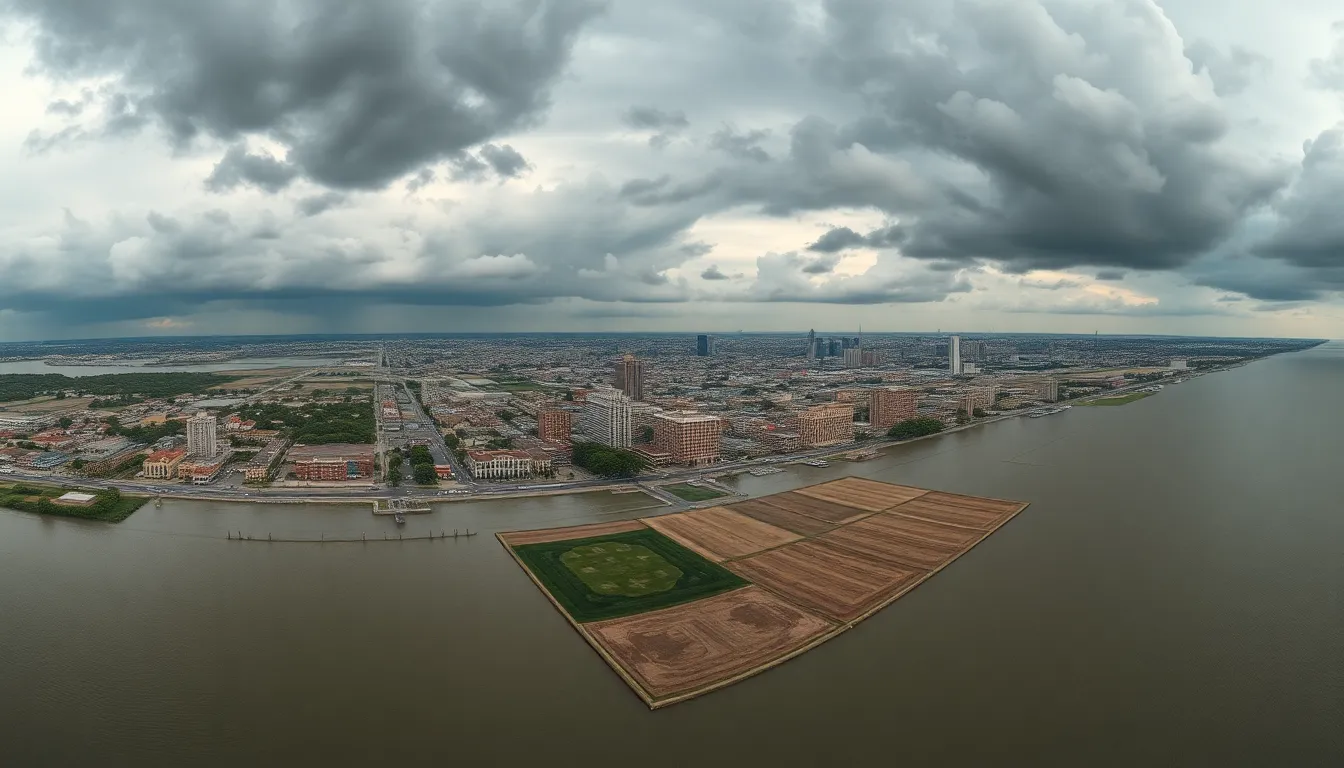Global warming isn’t just a hot topic; it’s literally heating up the planet. As temperatures rise, so do the stakes. From melting ice caps to unpredictable weather patterns, the effects of global warming are like that unwelcome party guest who just won’t leave. They’re here, they’re loud, and they’re causing chaos everywhere.
But it’s not all doom and gloom. Understanding these effects can empower individuals and communities to take action. Whether it’s rising sea levels threatening coastal cities or wildlife scrambling to adapt, the impacts are profound and far-reaching. Dive into the world of global warming effects and discover how they touch every corner of life on Earth, reminding us that it’s time to roll up our sleeves and make a difference.
Table of Contents
ToggleOverview of Global Warming Effects
Rising temperatures from global warming lead to significant environmental shifts. Melting ice caps result in rising sea levels, threatening coastal cities with flooding. Extreme weather patterns, including more intense storms and prolonged droughts, disrupt ecosystems and human communities alike.
Wildlife faces dire consequences as habitats change rapidly. Species that cannot adapt quickly enough face extinction. Ocean acidification, caused by increased carbon dioxide levels, undermines marine life and coral reefs.
Agricultural sectors also suffer. Crop yields decline due to changing climate conditions, affecting food security worldwide. Communities reliant on agriculture experience increased economic instability as productivity fluctuates.
The health implications are also profound. Heatwaves lead to higher instances of heat-related illnesses, while shifting disease patterns place vulnerable populations at greater risk. Air quality deteriorates from increased pollution, causing respiratory problems.
Climate migration emerges as people flee affected areas, leading to overcrowding in urban centers. Such migration brings social challenges, including resource competition and potential conflict.
Mitigation and adaptation strategies remain crucial. Nations and communities must collaborate on solutions to address these critical issues. Combining efforts can enhance resilience and promote sustainability in the face of these changes.
Environmental Impacts

Global warming leads to serious environmental changes, influencing various ecosystems and communities globally. The effects of climate change manifest in multiple ways, notably through rising sea levels and extreme weather events.
Rising Sea Levels
Melting ice caps contribute significantly to rising sea levels. Coastal cities face alarming threats as water encroaches on land, leading to increased flooding risks. The phenomenon affects about 680 million people living in low-lying areas. Infrastructure suffers as foundations erode and essential services become compromised. Salinization of freshwater sources becomes more prevalent, further jeopardizing drinking water availability. Agricultural lands see decreased productivity, impacting food supply. Urban regions invest heavily in adaptation strategies, yet many remain vulnerable.
Extreme Weather Events
Extreme weather events, such as hurricanes and droughts, grow more frequent due to climate change. These incidents result in devastating impacts on human communities and natural ecosystems. The frequency of Atlantic hurricanes has increased by about 30 percent since the 1980s. Each of these storms causes injury, property damage, and loss of life. Droughts lead to water scarcity, stressing food production and human health. Ecosystems struggle to adapt as habitats change without notice, risking species extinction. The unpredictable climate also complicates disaster preparedness efforts, making resiliency a critical priority.
Biological Consequences
Global warming drives significant biological consequences, impacting ecosystems and species worldwide.
Loss of Biodiversity
Loss of biodiversity occurs as habitats transform rapidly due to climate change. Altered climate conditions push many species to adapt or face extinction. More than 1 million species are currently threatened with extinction, according to the Intergovernmental Science-Policy Platform on Biodiversity and Ecosystem Services (IPBES). Changes in temperature and precipitation disrupt migration patterns, breeding cycles, and food availability. This shift affects not only wildlife but also human populations that rely on diverse ecosystems for resources. Healthy ecosystems provide essential services, such as pollination, water filtration, and climate regulation. As biodiversity declines, the resilience of these systems weakens, leading to further ecological imbalance.
Coral Bleaching
Coral bleaching results from elevated sea temperatures and increased carbon dioxide levels. The phenomenon occurs when corals expel the symbiotic algae living in their tissues, causing a loss of color and vital energy sources. According to the National Oceanic and Atmospheric Administration (NOAA), approximately 75 percent of the world’s coral reefs are at risk of bleaching. Coral reefs support about 25 percent of marine species, making their health crucial to overall ocean biodiversity. Furthermore, the loss of coral reefs impacts fishing industries, coastal protection, and tourism. As oceans warm and acidify, the survival of coral ecosystems hangs in the balance, directly affecting marine life and coastal communities.
Socioeconomic Effects
Global warming significantly impacts socioeconomic structures worldwide. Agriculture and food security face critical challenges as changing climate conditions disrupt growing seasons and reduce crop yields. Wheat, a staple for millions, has seen reductions due to increased temperatures. Farmers grapple with unpredictable weather, leading to food scarcity and rising prices. Rural communities reliant on agriculture experience economic strain, with food insecurity affecting vulnerable populations.
Health risks associated with global warming escalate as heat-related illnesses and respiratory conditions rise. Higher temperatures increase the prevalence of heatwaves, leading to more hospital visits. Air quality worsens due to increased pollutants in warmer environments. Vulnerable groups, including children and the elderly, suffer exacerbated health issues. Mental health also declines as communities face climate anxiety and resource scarcity. Access to adequate healthcare becomes increasingly important, particularly in hard-hit areas.
Mitigation Strategies
Mitigation strategies play a vital role in addressing the effects of global warming. Focusing on renewable energy and policy changes can significantly reduce greenhouse gas emissions.
Renewable Energy Solutions
Wind, solar, and hydropower technologies generate clean energy, replacing fossil fuels. Producing electricity from renewable sources leads to lower carbon footprints. Solar energy alone has the potential to power millions of homes, reducing reliance on coal and natural gas. In 2021, U.S. solar installations reached approximately 23.6 gigawatts, reflecting a growing shift toward sustainable energy. Implementing these solutions leads to job creation in the renewable energy sector, reinforcing energy security and resilience. Support for innovation and technology developments further accelerates the transition toward renewable energy.
Policy Changes
Strong policy measures drive significant reductions in carbon emissions. Implementing carbon pricing encourages businesses to adopt greener practices. Regulations on emissions standards for vehicles promote cleaner transportation options. The Climate Action Plan aims to cut U.S. greenhouse gas emissions by 50-52 percent by 2030, setting ambitious targets. Encouraging international agreements amplifies collective efforts to combat climate change. Investing in sustainable infrastructure fosters long-term economic growth while ensuring environmental protection. Collaborative policymaking prioritizes sustainability, balancing economic and environmental needs.
Global warming presents urgent challenges that demand immediate attention and action. The interconnected effects on ecosystems, human health, and economic stability highlight the need for a collective response. By embracing renewable energy solutions and implementing effective policies, communities can mitigate these impacts and foster resilience.
While the road ahead is daunting, there’s hope in the potential for innovation and collaboration. Individuals and organizations alike play crucial roles in driving change. With informed action and commitment to sustainability, it’s possible to create a healthier planet for future generations. The time to act is now, and every effort counts in the fight against global warming.


